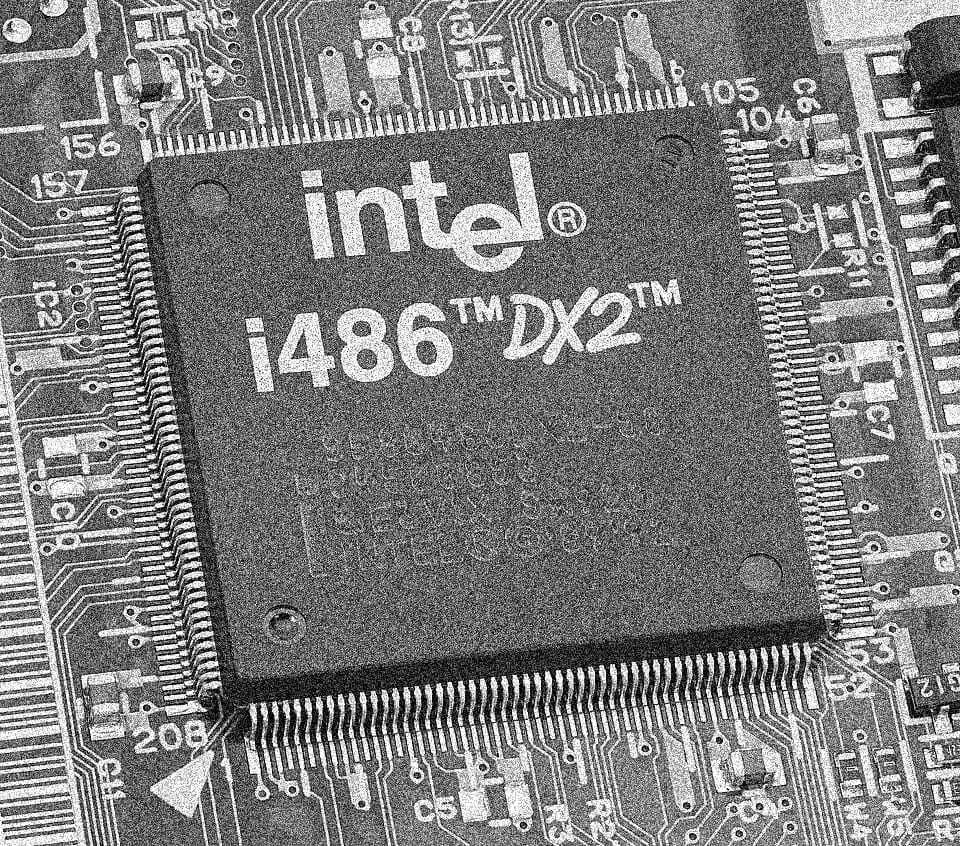Intel, Trump, and the Future of Bidenomics
Trump just announced a partial nationalization of one of America’s biggest tech giants. This is not contrary to Biden-era industrial policy but an extension of it, as well as an opportunity for greater public control over private capital.

The Trump administration just made a groundbreaking announcement that the US government is taking a 10% equity stake in Intel, making it Intel’s largest shareholder. This follows a trend of the Trump White House showing initiative in seizing the means of production—well, at least in buying part of it.
When Japan’s Nippon Steel acquired US Steel, the Trump administration secured ownership of a “golden share” that forces the company to consult the government on important decisions and hold them accountable to promises on future investments in the US. In order to jump-start domestic rare earth magnet production, the Department of Defense took a 15% equity stake in MP Materials. What differentiates this newest move by the Trump administration is both the size of the deal and the significance of the company. The Nippon Steel golden share is a non-financial asset, and the MP Materials stake was purchased at a mere $400 million. This newest deal is a huge $11.1 billion and a partial nationalization of a flagship American tech giant.
For all of Trump and Biden’s differences, both administrations showed a clear willingness to spurn free market principles and an earnest interest in reindustrializing America. Through the CHIPS Act, the Biden administration wielded industrial policy to spur massive investments in semiconductor manufacturing. Trump’s erratic and incompetent approach to tariffs has completely backfired in reinvigorating manufacturing, but underlying it is a genuine vision of reindustrialization.
Despite Trump’s vow to end the CHIPS Act, his latest move is best understood as an extension of the CHIPS Act, not a rejection of it. Through the very different Biden and Trump administrations, the American state has made a decisive choice to intervene in the economy for the long-term goal of increasing domestic semiconductor manufacturing. Trump’s partial nationalization of Intel should be seen as the latest, and most aggressive, contribution to a continuing strategy towards this goal.
The US: Designers Who Can’t Build
To understand the significance of this deal and its place in the longer arc of US semiconductor industrial policy, we need to zoom out and take stock of the global chip industry. Semiconductors are an absolutely crucial input needed for almost every electronic device in existence. Everything from coffee makers to smartphones to advanced weapons systems all rely on chips to function, leading some to refer to it as “the new oil.” Even for sectors that seem far away from tech like agriculture, electronic devices and the chips they run on are necessary for maintaining basic operations. The global economy and the modern world itself exists on the back of the semiconductor industry.
The US is undoubtedly a giant in this crucial sector. NVIDIA controls almost the entirety of the market for AI chips. AMD is one half of the duopoly on PC CPUs and designs one of the few alternatives to NVIDIA’s AI chips. Apple’s ubiquitous iPhones and MacBooks are powered by their A- and M-series chips. Qualcomm controls a massive share of the smartphone processor market with its trusted Snapdragon design. The US even monopolizes the key software programs that are necessary for designing these chips. In short, America is the undisputed leader in semiconductor design.
But when it comes to actually manufacturing these designs, the US is sorely behind. The US has a few semiconductor manufacturers like GlobalFoundries, Texas Instruments, and Micron. But even though these are US-headquartered companies, that doesn’t mean they manufacture on American soil. Micron makes 90% of its chips abroad, mostly in Taiwan. In addition, none of these firms except Intel, which both designs and manufactures, is capable of making the most technologically cutting-edge logic chips. For their best chips, American chip designers rely on Taiwan Semiconductor Manufacturing Corporation (TSMC) for transforming designs from drawings on a computer screen into an actual physical product. Following the “fabless” model, most American chip companies design chips and then contract TSMC for their manufacturing. As a result, TSMC controls a shocking 67% of the global foundry market. For the most advanced chips needed for smartphones, laptops, and AI chips, TSMC’s market share bumps up to over 90%. In addition to TSMC is the rarely noted, but still major, Taiwanese chip manufacturer United Microelectronics Corporation. When it comes to actually manufacturing chips, most routes pass through Taiwan.
The CHIPS Act
In both an attempt to counter China and reduce this major supply chain vulnerability, the Biden administration embarked on the CHIPS Act, a decisive shift towards embracing industrial policy. It allocated a massive $53 billion to renewing semiconductor manufacturing on American soil by using the carrots of subsidies and tax credits to direct private investment towards the sector. Though some portrayed the CHIPS Act as simply a form of corporate welfare, this claim doesn’t hold up to scrutiny. The CHIPS Act was filled with conditionalities that set restrictions on how firms could use subsidy money, including profit-sharing agreements, unionization requirements, and prevailing wage clauses. Most importantly, the Biden administration set performance requirements through timelines and milestones for subsidy recipients. Grant money would only be disbursed when companies hit these milestones. In cases where firms failed to live up to their side of the bargain, the government could claw back the award money.
As more evidence that the government was insulated from corporate lobbying, the Biden administration happily sidelined American non-manufacturing chip designers also looking for subsidies because they couldn’t contribute to the state’s strategic goal of increasing manufacturing. Designers are larger firms that can wield comparatively more economic might than manufacturers and have greater lobbying power. On the day of the CHIPS Act’s passage, NVIDIA’s market capitalization was quadruple that of Intel’s. But despite having more money to burn on lobbying, semiconductor designers failed to get support from the CHIPS Act.
In addition, the Biden administration ignored its own domestic chip designing capitalists in favor of foreign companies that could actually contribute to its strategic goals. Although Intel received the CHIPS Act’s largest grant, TSMC and Samsung received comparably large packages of $6.6 billion and $4.7 billion to start manufacturing in the US. Thus, the Biden administration ignored the protests of massive chip designers like NVIDIA, AMD, and Qualcomm and instead chose to subsidize foreign players who could actually advance industrial policy goals. If the CHIPS Act was simply corporate capture of the state, its support would have all been directed to domestic firms looking for protection, not subsidizing foreign competitors. On top of manufacturing more chips on US soil, bringing in foreign chipmakers applied competitive pressure on domestic chip manufacturers. Subsidy recipients couldn’t simply fritter away their government cash because foreign competitors were also being subsidized by the American government and threatened to take their market share.
Thus, the CHIPS Act was not corporate welfare, but rather a strategic industrial policy carried out by the American state with the clear goal of onshoring semiconductor manufacturing. To make sure that the private sector worked towards this goal, the US government employed two ways of disciplining domestic semiconductor capital: the direct administrative discipline from the state’s ability to disburse and retract subsidies and the indirect market discipline created by the invitation of subsidized foreign competitors.
Despite only passing a few years ago, the CHIPS Act has already accomplished a lot. It has spurred over $500 billion of investment in semiconductor manufacturing, meaning that every $1 of public spending crowded in $10 of private investment. Even controlling for pandemic-era inflation, chip manufacturing investment jumped from a mere $7 billion in 2020 to $90 billion in 2024. This $90 billion was not merely empty promises, but rather real physical construction that commits manufacturers to following through. Semiconductor manufacturing plants that fill various segments of the supply chain from memory chips to metrology to advanced packaging have sprouted up across the US. Perhaps most significantly, TSMC Arizona has already started producing advanced logic chips, blasting through one of chip manufacturing’s most challenging technological bottlenecks in record time.
Why Intel?
Many American chip manufacturers received support through the CHIPS Act. But what makes Intel special is that it’s the last US company that’s capable of making the advanced leading-edge logic chips used in high-tech products like smartphones, laptops, and AI chips. There are currently only three companies in the world that have the ability to make these advanced chips: TSMC, Samsung, and Intel. But to call this a triopoly would be a mischaracterization. TSMC currently controls 90% of the market for these chips and is continuing to advance at a rapid clip while Samsung and Intel are barely holding on. Intel’s manufacturing services have failed to attract customers and are hemorrhaging money, with a reported loss of $13 billion last year. Intel doesn’t even have the capacity to manufacture all of its own chip designs and has to outsource to TSMC to produce its most recent chipsets. Thus, Intel was the largest recipient of the CHIPS Act and the focal point of US industrial policy not only because it’s the only American player in the advanced chip game, but also because it desperately needed help.
If the market simply took its course, Intel would likely be forced to sell off its manufacturing operations or give up advancing its manufacturing technology to settle for making lower-end chips. Intel’s primary competitor, AMD, did exactly this when it spun off its manufacturing arm into GlobalFoundries in 2009. GlobalFoundries subsequently gave up on researching new process nodes in 2018 and settled for producing simpler mature-node chips. Given the technological challenges of semiconductor manufacturing and the astronomical fixed capital costs, the natural tendency of the market is ever-increasing concentration with lagging manufacturers pushed out of the market or giving up on furthering chip technology. But the American state has understandably deemed this an unacceptable outcome for three key reasons.
First, the technological barriers to semiconductor manufacturing are borderline insurmountable for new market entrants. Manufacturing advanced semiconductors involves layering materials onto silicon wafers, with each layer being as small as a billionth of a meter. Hundreds of billions of transistors that are each a fraction of the size of a coronavirus particle are etched onto these layers. While most manufacturing processes can accommodate minor variations or errors, being just a few atoms off can result in an unusable chip. The margin of error is literally at the atomic level.
Described above are just a few of the thousands of different process steps required, each requiring highly specialized engineering knowledge. These technological barriers make starting a firm from scratch that is competent enough to carry out each of these steps basically impossible. Getting an existing semiconductor manufacturer to “leapfrog” from making lower-end chips to state-of-the-art chips is also implausible, as cumulative knowledge gained from incremental advances is necessary for making more advanced chips. Thus, if America later decides that it wants to invest in advanced chip production again, it’ll already be too late. The fall of Intel’s manufacturing would mark the permanent end of American leading-edge chip manufacturing. There would be no going back.
Second, the end of Intel’s advanced chip manufacturing would amplify already massive supply chain security risks in Asia. Aside from Intel, only Samsung in South Korea and TSMC in Taiwan are capable of making leading-edge semiconductors. Both are neighbors with America’s largest geopolitical rival, China, and South Korea has the additional geopolitical risk of nuclear-armed North Korea. In addition to the China threat, Taiwan sits on the extremely seismically active Ring of Fire. A major earthquake could paralyze the global electronics industry. While the CHIPS Act has mitigated this risk by bringing some of Samsung’s and TSMC’s manufacturing capacity to the US, the dependence on Asia still runs deep. Samsung’s and TSMC’s best R&D facilities and most advanced technology remain in their home countries. Despite its rapid expansion, TSMC’s planned production in Arizona will only account for 5% of its overall output. In addition, TSMC’s chips made in America still have to be flown to Taiwan to carry out crucial steps of the manufacturing process (though some of this capacity is being brought to the US). Without Intel, the global chip industry becomes entirely dependent on Asia for leading-edge semiconductors.
Third, a semiconductor manufacturing sector with fewer major players will be less technologically dynamic and bottleneck long-term economic growth. The advanced chip manufacturing industry already only has three players, with TSMC far ahead of both Intel and Samsung. If Intel and Samsung are knocked out of the market, leading-edge chip manufacturing will become a complete TSMC monopoly. In this scenario, TSMC would lose all competitive pressure to improve its technology and could rest on its laurels. At a time when the rate of technological progress in semiconductor manufacturing has already started declining, a total TSMC monopoly could lead to a further slowdown. As the bedrock of the modern world, a semiconductor technological slowdown could redound to the rest of the global economy. If AI really leads to breakthroughs in economic productivity, a TSMC that’s less motivated to push the technological frontier could hold back AI’s progress and leave a lot of potential growth on the table.
Interpreting the Art of the Deal
While far from perfect, there’s a lot to like in the deal. Trump has no interest in preserving the CHIPS Act’s progressive conditions like union labor requirements and employer-provided childcare, but his latest move is fundamentally a continuation of the CHIPS Act. The $11 billion investment in Intel converts already awarded CHIPS Act grants into an equity purchase of 10% of the company. Trump’s deal entirely relies on CHIPS Act funding, but improves the terms by turning a giveaway into government ownership. Bernie Sanders has come out in support of the deal, saying: “If microchip companies make a profit from the generous grants they receive from the federal government, the taxpayers of America have a right to a reasonable return on that investment.” Keeping in-line with the CHIPS Act’s strategic goal of supporting domestic manufacturing, the deal includes a warrant that gives the government the right to purchase 5% more of Intel if it divests more than half of its manufacturing business. In essence, that means that the government is threatening further nationalization if Intel tries to give up manufacturing chips.
On the negative side, the deal specifies that the government’s investment is only passive, meaning that it doesn’t have board representation or governance rights. Given that this is now an equity purchase rather than a grant, the government no longer can claw back its money. Thus, the deal involves far less than the US government actually seizing and controlling corporations. Regardless, this is a historic nationalization the likes of which we haven’t seen since the nationalization of GM in 2009. The GM nationalization was only politically possible because of the 2008 global financial crisis and was always intended as a temporary measure. This time, the state has broken the taboo on nationalization without the justification of a major crisis, and there is no indication that this is just a temporary arrangement. Trump administration officials have even indicated interest in pushing further and taking equity stakes in more semiconductor companies. If the Left ever finds itself in the White House, this sets a new helpful precedent on how much we can intervene in the market economy.
For those who support reindustrializing the US with state-led industrial policy, this deal should be seen as a victory. The Intel board chairman’s goal of spinning off its manufacturing segment has been defeated, and the company has gotten a new lease on life. In addition, a resilient semiconductor supply chain should be more desirable for everyone. The Covid pandemic revealed that weak supply chains can easily lead to shortages and rising prices. The entire global economy shouldn’t be capable of being held hostage by either Beijing’s belligerence or the shifting tectonic plates below Taiwan.
Whether this latest move really marks the beginning of an Intel comeback remains to be seen. The company’s problems run deep and the semiconductor sector is so complex that it can take many years to correct course. Intel is still far behind TSMC and has a lot of catching up to do to become competitive once again. $11 billion is a sizable sum, but still only about half of the cost of a cutting-edge semiconductor manufacturing plant. Nonetheless, this still represents Intel's most hopeful moment in years. The nationalization addresses one of Intel’s key bottlenecks, securing chip designer customers for its cutting-edge manufacturing. The US government is actively cosigning as Intel’s guarantor, improving designers’ confidence in Intel as a manufacturer. Chip designers looking to exploit Trump’s penchant for flashy deals might want to contract Intel as a way of currying favor with the president.
Of course, the worst aspect of this deal is that it was made by the Trump administration. While watching the state browbeat capitalists into a deal is satisfying, the underlying authoritarian dangers should not be underestimated. In addition, the American state’s renewed interest in semiconductor manufacturing is undoubtedly motivated by a hawkish attempt to contain China. While the CHIPS Act had many admirable conditions, it also included a clause that banned grant recipients from expanding manufacturing in China. Regardless, bad intentions can sometimes serve worthwhile ends. Revitalizing American chip manufacturing and diversifying the fragile semiconductor supply chain are positive goals that should be supported.
If the Left ever controls state power, it also has to be willing to use the power of government to intervene in the market and control private capital for strategic ends. In this respect, Trump has just expanded the boundaries of political possibility. We should follow Bernie’s lead in supporting this partial nationalization of Intel, but remain cognizant of the dangers that lie ahead.
■
Daniel Cheng is a former Sociology PhD student and independent researcher on Chinese technology and political economy.



